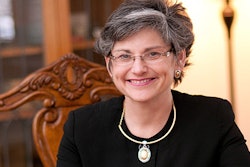A new report from the Penn Center for Minority Serving Institutions (CMSI) at the University of Pennsylvania explores the dearth of women in presidential positions at Minority Serving Institutions (MSIs).
While approximately 50 percent of college students in the United States are women, the people who occupy the presidency of those institutions of higher learning don’t reflect the student population. A report from CMSI notes that less than 30 percent of all college presidents are women, and that number is less than 12 percent at 650 MSIs. This includes HBCUs, Hispanic Serving Institutions (HSIs), Native and tribal colleges and Asian American/Pacific Islander-serving institutions.
 Amanda Washington Lockett
Amanda Washington Lockett“There are still a vast amount of antiquated stereotypes that surround women in leadership,” said Amanda Washington Lockett, a research associate at CMSI and lead author of the report. “When we’re thinking about the relationships that are necessary for women to build while getting into and maintaining these positions…there is a lot of information not being transferred to women who are interested in being presidents.”
Many male and female college and university presidents would say they didn’t envision themselves as presidents when they began their careers in academia. Their leadership talents were recognized by mentors and/or colleagues who set them on that path. Unfortunately, the number of women being identified and put on the path is in the extreme minority.
“You cannot handle or solve gender issues without men,” said Dr. Atiya S. Strothers, a research associate at CMSI. “If you’re trying to solve any type of issue that involves marginalized experiences or people that are within certain oppressed groups, if you deal with it with just those persons, you’re really not dealing with the issue. We can’t keep it just amongst women. You need advocates and allies who are willing to push the envelope and agenda.”
The report, Missing, but Vital: Strategies for Women Presidents at Minority Serving Institutions, identifies many of the challenges that women deal with. It sets out how to face and navigate those challenges.
“This report came about because we were thinking about women who have taken on presidencies recently and run into sexism on the job,” said Dr. Marybeth Gasman, director of CMSI and the Judy & Howard Berkowitz Professor of Education at Penn. “We started thinking about what kind of message does it send to women who want to be presidents when they see the women who go before them encountering sexism and their leadership being called into question.”
One of the goals of the report is pushing individuals to embrace the fact that there should be leadership representative of student populations and the nation as a whole, Gasman said, adding that those interested in leadership need to be cultivated, mentored and given opportunities. She said that those involved in preparing the report are women of color, who aspire to be leaders in academia.
“It’s very important to plant that seed because it allows for it to be nurtured and watered along the way on this road to the presidency,” said Strothers.
Developing the pipeline puts more women in visible positions to be considered for presidencies, added Strothers.
The report notes that women uplifting other women is a vital part of building for the future. As aspiring future leaders recognize and capitalize on their own strengths and leadership styles, they must also learn the nuances of a presidential position. This can involve learning campus cultures and priorities as well as discovering the ins and outs of boards of trustees.
“The historical lens is very important, because a lot of these MSIs are connected to their history and culture,” Strothers said. “You can’t make change unless you take that into account.”
It is crucial that women considering becoming presidents learn how to recognize and overcome discrimination and pay inequities, according to the authors of the report. There is also discussion of the balance women face when it comes to family
“We have a piece on how to maintain your personal values while in the office of president,” said Washington Lockett, a doctoral student at Penn and a graduate of Spelman College.
Obstacles such as imposter syndrome — feeling you don’t actually belong in the position — and stereotype threat, or navigating negative stereotypes, can be understood and overcome more easily with mentorship, said Washington Lockett.
“There needs to be stronger mentorship, both women to women but also men, as well,” she said. “The narratives of presidents and the experiences that they go through are very important in that mentorship process.”
Washington Lockett hopes the report gives voice to aspiring women leaders.
Another strategy, she said, is “seeking out women who show leadership skills or potential and intentionally mentoring those women and pouring into them the things that they’ll have to know and some of the strategies they’ll have to implement…Beginning to cultivate and groom those women as leaders.
The report offers 29 presidential tips such as embracing gender and racial diversity, being open to multitasking, collaborating with other women, establishing open lines of communication with senior and veteran faculty members, learning institutional traditions and establishing mentor/mentee relationships with women across academia.
“Leadership can be attained by women,” said Washington Lockett of the quotes from women leaders included in the report. “It’s important for qualified women to step up to the plate and also to have the opportunities to step up as leaders of MSIs.”
Gasman knows progress can be made. One of her former students at the University of Pennsylvania, Dr. Linda Oubré, was just named president of Whittier College, a Hispanic-serving and Asian American-serving institution in California.
“On the day this [report] was released, she was announced,” said Gasman. “That gives me hope that there will be more women of color.”



















